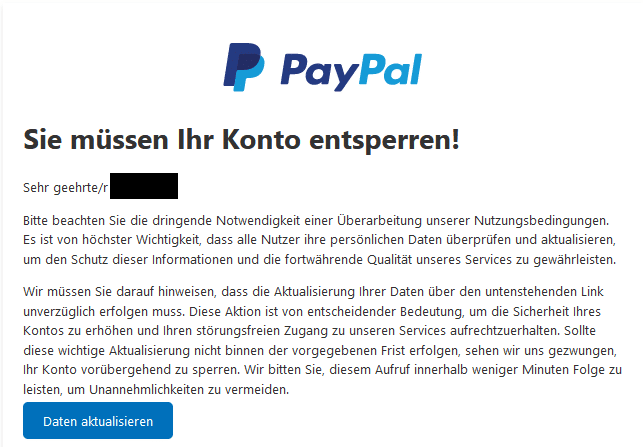In view of the recent changes to PayPal's General Terms and Conditions (GTC), consumer advice centers are urgently warning of a current wave of phishing.
Cybercriminals are targeting users of the popular payment service and are using the recent changes to terms and conditions as a pretext to send dangerous scam emails. This practice coincides with PayPal actually notifying its customers of the terms and conditions changes, increasing the credibility of the phishing attempts.
“Unlock your PayPal account according to new terms and conditions”
The fraudulent emails, sent under the pretense of unblocking the PayPal account according to the new terms and conditions, use the PayPal logo and a personal salutation to instill trust.

It is suspected that the cybercriminals are relying on information from previous data leaks in which users' names and email addresses were exposed.
The scam: urgency and false demands
The phishing emails suggest an urgent need to review and update users' personal information. This is presented as crucial to protecting information and maintaining quality of service.
Fraudsters put pressure on their victims by threatening to temporarily block the account if the update is not completed within a certain period of time. A button contained in the email that supposedly serves to update data actually redirects to a phishing page.
The consumer advice centers point out that the sender address of the emails already provides a clear indication of the phishing attempt. It is strongly recommended not to click on the link contained in the email and to watch out for signs of fraudulent forgery, especially in messages that create pressure to take action.
Protective measures and prevention
Consumers should always question the authenticity of emails, especially when they request actions involving sensitive personal information. Verifying the sender address, avoiding links in unknown emails, and contacting the service provider directly through official channels are effective strategies to protect yourself from phishing attempts.
Questions and answers about phishing attacks
Question 1: How do you recognize a phishing email?
Answer 1: Users should pay attention to incorrect return addresses, spelling errors, non-personalized salutations and links to unknown websites.
Question 2: What should those affected do if they receive a phishing email?
Answer 2: Those affected should not click on links, delete the email and, if possible, report the incident to their email provider.
Question 3: How can users effectively protect their accounts?
Answer 3: Using strong, one-time passwords, enabling two-factor authentication, and regularly reviewing account security are important steps.
Question 4: What is the goal of cybercriminals in these phishing attacks?
Answer 4: The goal is to steal sensitive personal information such as passwords and financial data in order to commit fraudulent acts.
Question 5: Why are PayPal-related phishing attacks particularly concerning?
Answer 5: PayPal is a widely used payment service and the theft of PayPal credentials can result in direct financial loss.
Conclusion
With the number of phishing attacks on the rise, especially those that take advantage of current events such as PayPal's change in terms and conditions, it is more important than ever to be aware of scammers' methods and take preventative security measures. This is not just about protecting individual user data, but about the integrity and security of digital payment transactions as a whole.
Recognizing phishing attempts and knowing how to properly handle suspicious emails are essential to protecting yourself and your digital assets.
Source: heise.de , consumer advice center
We invite you to sign up for the Mimikama newsletter and register for our online lectures and workshops . Stay informed and actively protect yourself from cybercrime.
You might also be interested in:
Notes:
1) This content reflects the current state of affairs at the time of publication. The reproduction of individual images, screenshots, embeds or video sequences serves to discuss the topic. 2) Individual contributions were created through the use of machine assistance and were carefully checked by the Mimikama editorial team before publication. ( Reason )

